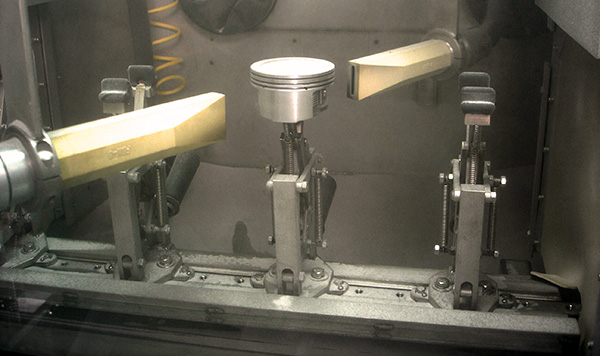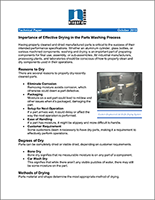Having properly cleaned and dried manufactured parts is critical to the success of their intended performance specifications. Whether an aluminum cylinder, glass bottles, or various machined components, washing and drying is an important part of preparing components for final use, assembly, or sub-assemblies. All industrial manufacturers, processing plants, and laboratories should be conscious of how to properly clean and dry components used in their operations.
Reasons to Dry
There are several reasons to properly dry recently cleaned parts.
- Eliminate Corrosion
Removing moisture avoids corrosion, which otherwise could deem a part defective. - Packaging
Moisture on a wet part could lead to mildew and other issues when it’s packaged, damaging the part. - Setup for Next Operation
If a part arrives wet, it could delay or affect the way the next operation is performed. - Ease of Handling
If a part has moisture, it might be slippery and more difficult to handle. - Customer Requirement
Some customers deem it necessary to have dry parts, making it a requirement to effectively perform operations.
Degrees of Dry
Parts can be completely dried or visible dried, depending on customer requirements.
- Bone Dry
Bone dry signifies that no measurable moisture is on any part of a component. - Car Wash Dry
This signifies that while there aren’t any visible puddles of water, there may still be some moisture on the part.
Methods of Drying
Parts material and shape determine the most appropriate method of drying.
- Heat
A convection oven is used to dry a part. - High-Pressure Blower
The part is dried using a high-pressure blower with a high-volume of air. - Compressed Air
This method also uses high air pressure, but with a lower volume, directing air into a specific area of the component. - Vacuum
The part is placed in a vacuum chamber which removes humidity from hidden interior surfaces.
“It may sound obvious, but if it’s not dried to the customer’s specifications, then it’s wet, which can result in detrimental consequences,” says Chris Langmack, director Niagara Systems. “We have decades of cleaning experience with a multitude of products and drying methods and can dry almost anything. We customize each washing and drying solution to meet the customers’ requirements.”
Niagara Systems has provided high-quality, long-lasting industrial dryers since its founding in 1934. We are experts at drying complex parts such as castings, bottles, totes, and cylinders.
Contact us today to learn how we can provide a drying system to meet your specific needs.


